Fostering Community Resilience to Food and Nutrition Crises in Haiti
Building skills and capacity alone is not enough. We have to fight inequality and injustice that make poor women and men more vulnerable in the first place.
Note: This case study by Welthungerhilfe reflects the views of this organization. It is intended not to present research findings, but rather to show examples from their practical work and experiences in the field.
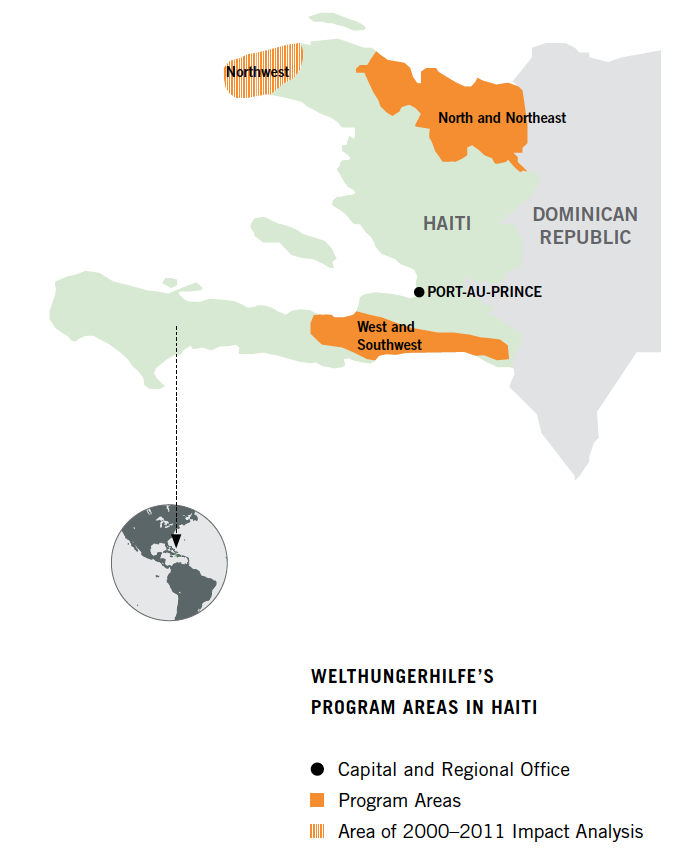
Source: Welthungerhilfe based on official maps.
After the devastating earthquake of 2010, the international community rallied around Haiti. In 2013, three and a half years later, international donors have begun to phase out earthquake-related assistance, despite the country’s extreme vulnerability to food and nutrition insecurity. Although the latest data show a positive trend, as recently as 2012 droughts and storms led once more to increased food and nutrition insecurity. In an environment that is not only highly exposed to natural hazards, but also vulnerable to recurrent economic and socio-political shocks and stresses, analyzing long-term programming using a “resilience lens” adds value.
Sources of Haiti’s Resilience Deficit
WIDESPREAD POVERTY AND CONTINUOUS FOOD INSECURITY. Haiti has suffered from widespread poverty and chronic food and nutrition insecurity for decades. Between 1990 and 2000, its GHI improved only a little, falling from a value of 33.8 to 25.7. Despite recent improvements, Haiti remains in the group of countries categorized in the GHI as “alarming” (2013 GHI score of 23.3), mainly because of widespread poverty that severely limits households’ access to sufficient nutritious food. More than half of Haiti’s households are trapped in absolute poverty and live on less than a dollar a day (Glaeser, Horjus, and Strother 2011).
NATURAL SHOCKS AND SOCIOPOLITICAL STRESSES. In 2012, Haiti was ranked the country most at risk from climate change (Maplecroft Global Risk Analytics 2011). By 2011, Haiti had experienced 34 major shocks in just one decade (Glaeser, Horjus, and Strother 2011). In addition to these larger-scale events, localized droughts, floods, landslides, and other smaller shocks also regularly undermine community and household resilience. More than half of all households affected by the 2010 earthquake were already in debt, with 95 percent of this debt related to food purchases (Haiti 2010). Haiti’s present risks are as much political as environmental. Weak governance can be observed across the four criteria commonly used for identifying fragile states: security, welfare, constitutional laws, and promotion of economic development (Radtke 2010).
AN EMERGENCY ECONOMY. The international community has arguably missed opportunities to contribute to a more robust public sector that could play a more prominent role in creating a resilience-enhancing policy framework. While evidence from Haiti and other countries, along with aid effectiveness and human rights principles, suggests that aid is most effective at strengthening public institutions when it is channeled through them, only 1 percent of post-earthquake relief aid and 12 percent of recovery aid went directly to the government using national systems (United Nations 2013a). Given the availability of substantial funding after each disaster and the seeming absence of a Haitian alternative, international NGOs and development consultants continue to be willing to take over public service delivery and job creation. Instead of strengthening the government and Haitian civil society, they have contributed to undermining their legitimacy and locked the country into a “humanitarian approach” and a dependency on aid (Haiti Grassroots Watch 2010).
Agriculture’s Role in Community Resilience
BOX 4.1
WELTHUNGERHILFE IN HAITI
For almost 40 years, Welthungerhilfe has been active in Haiti, supporting partners and projects in the areas of agroforestry and watershed management, improvement of rural infrastructure (irrigation and roads), disaster preparedness, and strengthening civil society. In 2011, the organization commissioned an external impact analysis of 10 years’ programming in Haiti’s North-West Department, one of the most food-insecure regions in the country.
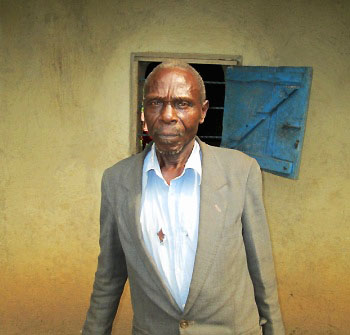
Alozio Businge,
Kabarole District, Uganda
I used to work as a watchman with Health, Water and Sanitation (HEWASA), a nongovernmental organization. In 2002, I had a car accident on my way to work. I was bedridden for one year and obviously lost my job. I am disabled and inactive. I cannot provide for my family as I used to. Life is very hard for me...The government and NGOs should adjust their rigid attitudes toward formal employment and begin to appreciate self-employment as the way to go. The government needs to take stringent measures to control population (for example, at most three children per family). Otherwise the situation will soon be uncontrollable.
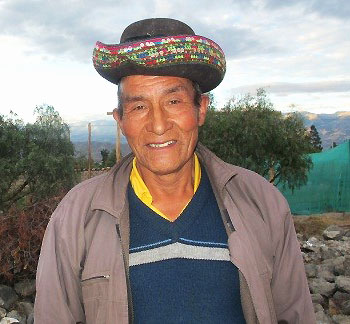
Guillermo Pacotaype,
Chuschi District, Peru
In order to assure my harvest and prevent possible damage caused by the weather, the project ECOCLIMA taught me about risk management. I started to cultivate my plants in separate plots within different ecological zones, and if I lose the harvest at one farm, I still have the other farms to harvest.
Most of the poor and food insecure live in rural areas. Smallholder farmers face difficult structural limitations, and still need to buy most of their food (Glaeser, Horjus, and Strother 2011). Thus, agricultural policies must play a key role in strengthening community resilience to hunger.
LOW PRODUCTIVITY, FRAGMENTED LAND HOLDINGS, UNSUSTAINABLE PRACTICES. Despite Haiti’s favorable growing climate, average cereal yields are much lower in Haiti than in its Caribbean neighbors Cuba and the Dominican Republic (Table 4.1 below).
What explains Haitian farmers’ relatively low cereal yields? Most farmers in Haiti are mountain peasants with small farms comprising several dispersed plots of land. Under Haiti´s land inheritance laws, multiple heirs share an interest in their land, which leads to continuing fragmentation of land holdings and weak land tenure. These conditions have made it easy for large-scale farmers as well as industrial and mining companies to acquire fertile lands (Cadre de Liaison Inter-ONG Haiti 2013).
Given the poor quality of their holdings and the constant exposure to environmental and climatic hazards, most peasants focus on reducing risk rather than maximizing production as a strategy for survival and food security. To manage risk and spread out harvest cycles, they actively diversify land portfolios and cropping patterns. At the same time, demographic pressure and poverty force the rural population to engage in activities, such as deforestation, which increase its vulnerability to risk. The deforestation leads to environmental degradation, soil erosion, and water shortage. Furthermore, because of land shortages, farmers increasingly farm on steep slopes with particularly fragile soils—a practice that leads to further erosion and land degradation.
Besides the declining size of land holdings and the high level of risk they are exposed to, small-scale producers are also constrained by a lack of investment leading to low levels of agricultural technology and inadequate infrastructure, strong migration out of rural areas, difficulties in accessing appropriate markets, and weak representation in policy debates.
UNFAVORABLE POLICY ENVIRONMENT FOR SMALL-SCALE PRODUCERS. In the aftermath of Hurricane Sandy in 2012, the Haitian government reaffirmed a commitment to agrarian reform and announced plans to increase Haiti’s capacity to meet 60–70 percent of its food security needs by 2017 (AlterPresse 2012; Joseph 2013). But so far, support for large-scale agribusiness development dominates, while little investment goes into restoring Haiti’s environment and into sustainable agriculture that benefits small farmers and helps feed local communities.
Some observers contend that donors, especially the International Monetary Fund, World Bank, and the United States, still actively promote a vision of export-oriented agribusiness-led development (Kennard 2012) that began in the 1980s with the structural adjustment programs recommended by the International Monetary Fund and World Bank. These programs did not lead to broad-based growth in Haiti’s agricultural sector. Instead, they favored an elite few and fostered dependency on imports. This dependency was further increased by large-scale food distribution programs that channeled more food into the Haitian market without considering local production and self-help capacities. Harmful policies, such as low import tariffs for rice, have made it difficult for local farmers to compete with cheap imports. Reliance on imports makes Haitians particularly sensitive to food price fluctuations on the world market and increases the food insecurity of the poorest.
Another challenge is the lack of a cross-sectoral approach to food and nutrition security. While the Ministry of Agriculture is in charge of ensuring food security, the Ministry of Health is responsible for nutrition. Thus far, it is unclear whether Haiti’s decision to join the international Scaling Up Nutrition (SUN) initiative in June 2012 is backed by sufficient political commitment to tackle malnutrition across sectors.
TABLE 4.1
AVERAGE CEREAL YIELDS IN CUBA, DOMINICAN REPUBLIC, AND HAITI, 1993–2011
| Country | Average cereal yields (kilograms / hectare) | |||
|---|---|---|---|---|
| 1993–1997 | 1998–2002 | 2003–2007 | 2008–2011 | |
| Cuba | 1,859 | 2,632 | 2,874 | 2,325 |
| Dominican Republic | 3,832 | 4,073 | 4,052 | 3,299 |
| Haiti | 947 | 912 | 947 | 941 |
Notes: Cereal yield, measured as kilograms per hectare of harvested land, includes wheat, rice, maize, barley, oats, rye, millet, sorghum, buckwheat, and mixed grains. Production data on cereals relate to crops harvested for dry grain only. Cereal crops harvested for hay or harvested green for food, feed, or silage and those used for grazing are excluded. The FAO allocates production data to the calendar year in which the bulk of the harvest took place.
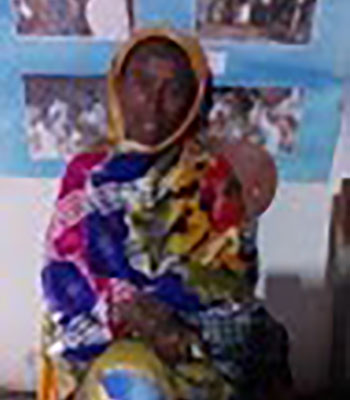
Nunu Desalegn,
Addis Ababa, Ethiopia
Life is very difficult due to inflation. Teff [Ethiopian grain] is very expensive. I used to buy 100 kilograms for 300 birr; now the price is 2,000 birr.... Previously we consumed lentils, vegetables, and meat, and now due to inflation we cannot afford to eat all these...Now, we can afford to eat meat only for holidays like Easter. I have no savings. I don’t know what will happen in an emergency.
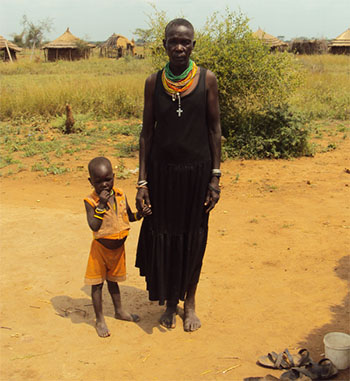
Maria Naok,
Karamoja District, Uganda
When my husband was still alive, we had some animals, cattle, and goats. We lost them all due to raids. The last chicken I had died from poultry cholera. That’s why I have no more animals at all...Last year, I cultivated the land and sowed, but there was no harvest at all. The rain was strong, the field was flooded, and all the plants died....” “As I harvested nothing last year and have no animals, I have to count on other sources to survive till the harvest comes. I cut firewood and produce charcoal, which I sell on the market. From the income, I buy some sorghum and make local beer from it, which I sell. I am actually preparing a garden and am planting some vegetable seedlings, grown in a nursery from seeds that we got from Welthungerhilfe.
FIGURE 4.1
Impact Chain of 10 years of programming in Haiti's North-West Department
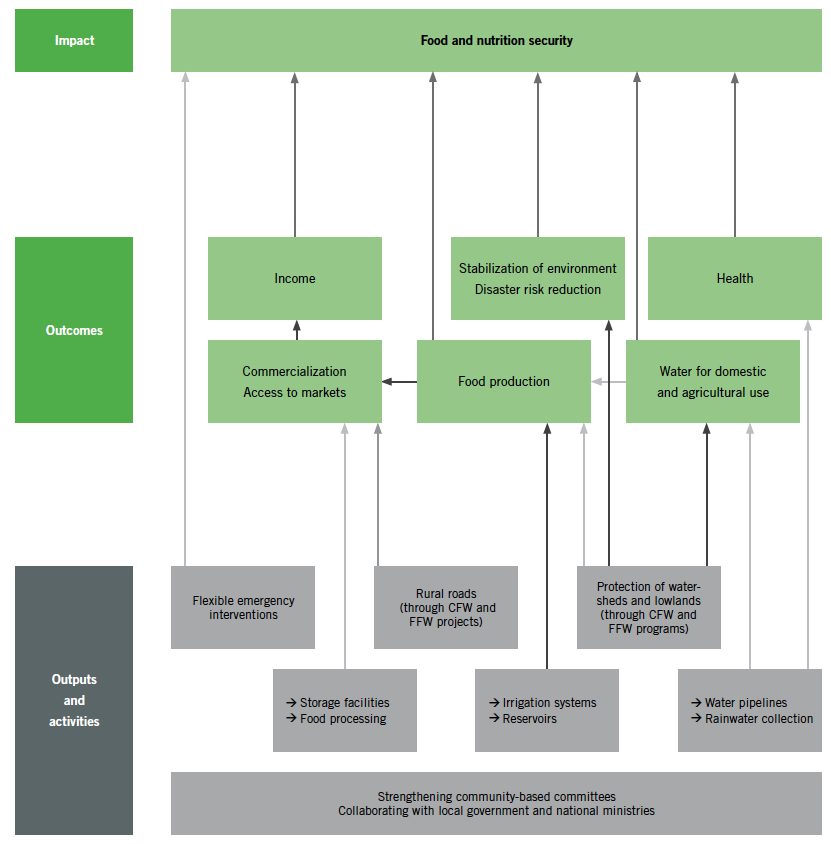 Source: Adapted from Kundermann, Excéus, and Almqvist (2012). Note: CFW = cash for work. FFW = food for work. These programs also contributed to temporary income. The arrow color indicates the intensity of proven impact.
Source: Adapted from Kundermann, Excéus, and Almqvist (2012). Note: CFW = cash for work. FFW = food for work. These programs also contributed to temporary income. The arrow color indicates the intensity of proven impact.
Welthungerhilfe’s Program and its Impacts
Haiti’s North-West Department is one of the regions most affected by structural food insecurity. More than 90 percent of the inhabitants depend on subsistence agriculture for their livelihoods. Since 1993, Welthungerhilfe has been working in the region, focusing on integrated food security and, since 2003, on the sustainable use of water resources to ensure food security and to improve living conditions. Given the regional context, Welthungerhilfe’s program of work in the area concentrated on improving food availability and access and gave less attention to nutritional issues. In total, 21 projects financed by a variety of donors were implemented between 2000 and 2011 and reached 37,000 households.
Although the program was not specifically designed to strengthen community resilience to undernutrition, it offers important lessons.
The program helped strengthen community resilience to food and nutrition insecurity by consistently addressing the structural root causes of food and nutrition insecurity and simultaneously making thoughtful use of emergency instruments, such as food- and cash-for-work. Looking at the program through a resilience lens allows us to identify key resilience factors for future programming.
The program in the North-West Department integrated several components in order to holistically protect a distinct watershed, to ensure access to remote areas, and to provide irrigation and water supply systems to the households involved. Flexible funding mechanisms for emergency interventions were included from the outset in order to offer an opportunity to react to acute needs when natural disasters struck (Kundermann, Excéus, and Almqvist 2012). Figure 4.1 illustrates the outputs and impacts achieved by the program and shows how the different types of interventions and programming levels are interrelated.
The external program analysis found the following direct and indirect impacts between 2000 and 2011:
-
Despite recurring shocks and stresses in this period, 4,800 households sustainably improved their food security, mostly by acquiring access to irrigation and water supply systems and benefiting from protected crop areas with high yield potential.
-
Household incomes grew thanks to agricultural yields that rose by 50–200 percent. Factors that contributed to these improved yields included irrigation systems, soil protection measures, better water supply systems, and better access to markets via newly constructed rural roads.
-
For many households, not only food availability and access, but also the quality of the food consumed improved. Vegetable consumption increased as a result of irrigated agriculture and diversification, and access to safe drinking water improved health (reducing the incidence of diarrhea by 20 percent) and nutrition.
-
Food deficits during acute crises were reduced by an estimated 30–50 percent, mostly because of the introduction of flexible and well-targeted food-for-work and cash-for-work programs during acute emergency phases. As a result, households were better able to avoid harmful coping strategies such as the sale of animals, loss of assets, or charcoal production leading to further deforestation.
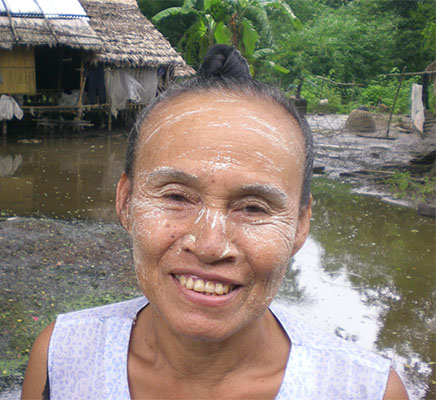
Daw Kae Phyo,
Yangon Division, Myanmar
In 2007, Cyclone Nargis destroyed my house as well as the harvest from a field for which I had saved up money to rent for one paddy season—to try and get out of debt. As I could not pay the landowner the final land rental fee, I was arrested and stayed in jail until I could borrow money from a local moneylender at 15 percent interest per month.
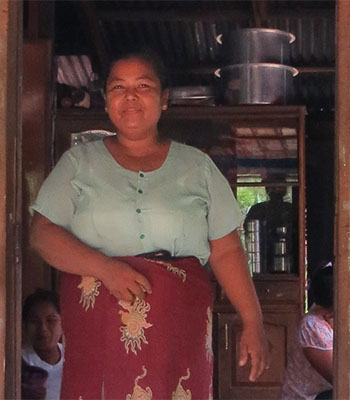
Daw Hnin Aye,
Yangon Division, Myanmar
We don’t need to worry about urgent household expenditures as before, as we can access money from the savings group on short notice and at an interest rate that we can manage to repay. In former days, we would live in constant worry that we would need to seek financial help from outside the community if our children fell sick, or if we had a bad month of work, or a bad harvest. Now we can manage ourselves and cover our own needs and unexpected financial expenses. Also, if we have another storm, such as Nargis, we can help each other to recover.
Ingredients of Resilience
An analysis of programming through a resilience lens revealed that many factors are important for strengthening community resilience to undernutrition.
-
By addressing several underlying, structural causes of vulnerability (such as inadequate infrastructure, inappropriate technologies, and difficult-to-access markets), the program contributed to positive long-term prospects of moving people out of hunger and poverty. To further strengthen nutrition security, a specific and detailed vulnerability analysis must be conducted on a local level.
-
Though sustainable food and nutrition security were their main goals, interventions were also designed to mitigate disaster risks and to anticipate, respond to, and cope with shocks and stresses such as landslides, flooding, or earthquakes. The long time horizon and continuity of the program, notably in strategies and staffing, permitted a development-oriented response to acute crises. One key to success was an in-depth analysis of local self-help capacities after each emergency and support to fill gaps in capacity. Flexible, accurately targeted emergency funding to address these gaps supported the community in pursuing long-term development goals. Given the likelihood that natural hazards in Haiti’s North-West Department will increase further the importance of well-targeted humanitarian aid, the issue of social protection and insurance for risks must be addressed at a higher level by governmental institutions, civil society, and major donors. Otherwise, emergency interventions, if not properly conducted, risk continuing to undermine self-help capacities and locking Haiti further into a humanitarian approach.
-
The program fostered the emergence of local committees, such as water management committees, which can, in the medium to long term, become the nucleus of an organized rural civil society that is better equipped to collectively mitigate risks. So far, the committees remain fragile. Continuous cooperation with the government to ensure institutional support for these committees after the program ends is important also for the future.
-
The program was aligned with national policies guiding agriculture and rural development, drinking water and hygiene, food security, environmental protection, and disaster risk reduction interventions. Through close cooperation with state structures and community administrations, their capacity for contingency planning and effective action is strengthened.
This combination of factors has helped strengthen community resilience to undernutrition in the North-West of Haiti. Given Welthungerhilfe’s intensive and long-term engagement, opportunities to foster resilience-enhancing policy change and to monitor implementation of such policies should be used to strengthen governmental accountability and leadership. This can be done in partnership with other NGOs and by supporting Haitian civil society organizations.
The Welthungerhilfe conference “Haiti beyond Emergencies: Haitians as Actors for Their Own Development” in Port-au-Prince in December 2012 opened a space for dialogue between Haitian civil society and government. It was a positive step in moving Haiti toward having a greater say in its future development. It underscored the importance of Haitian society as the main driver in its own sustainable development and in building a resilient environment.
Footnotes
- Findings from the 2012 Haiti Demographic and Health Survey (DHS) were not considered in Haiti's 2013 GHI score, because the report became available after data compilation for the GHI ended. Compared to the 2005–2006 Haiti DHS, the 2012 Haiti DHS indicates tangible improvements in child malnutrition (Cayemittes et al. 2007, 2013). FAO's data on undernourishment and dietary energy supply per capita also show a positive trend for recent years (FAO 2013a).
- Out of 100 people who cannot meet their basic needs, 77 are in rural areas, 9 are in the greater Port-au-Prince metropolitan area, and 14 are in other urban areas. A 2007 Comprehensive Food Security and Vulnerability Assessment found that rural households bought 68 percent of their food. These purchases equal 59 percent of their total expenditures (Glaeser, Horjus, and Strother 2011).
- In the mid-1990s, US President Bill Clinton supported dramatic cuts to Haiti’s tariffs on imported US rice. On March 10, 2010, however, he told the US Senate Foreign Relations Committee, “It may have been good for some of my farmers in Arkansas, but it has not worked. It was a mistake” (Democracy Now 2011).